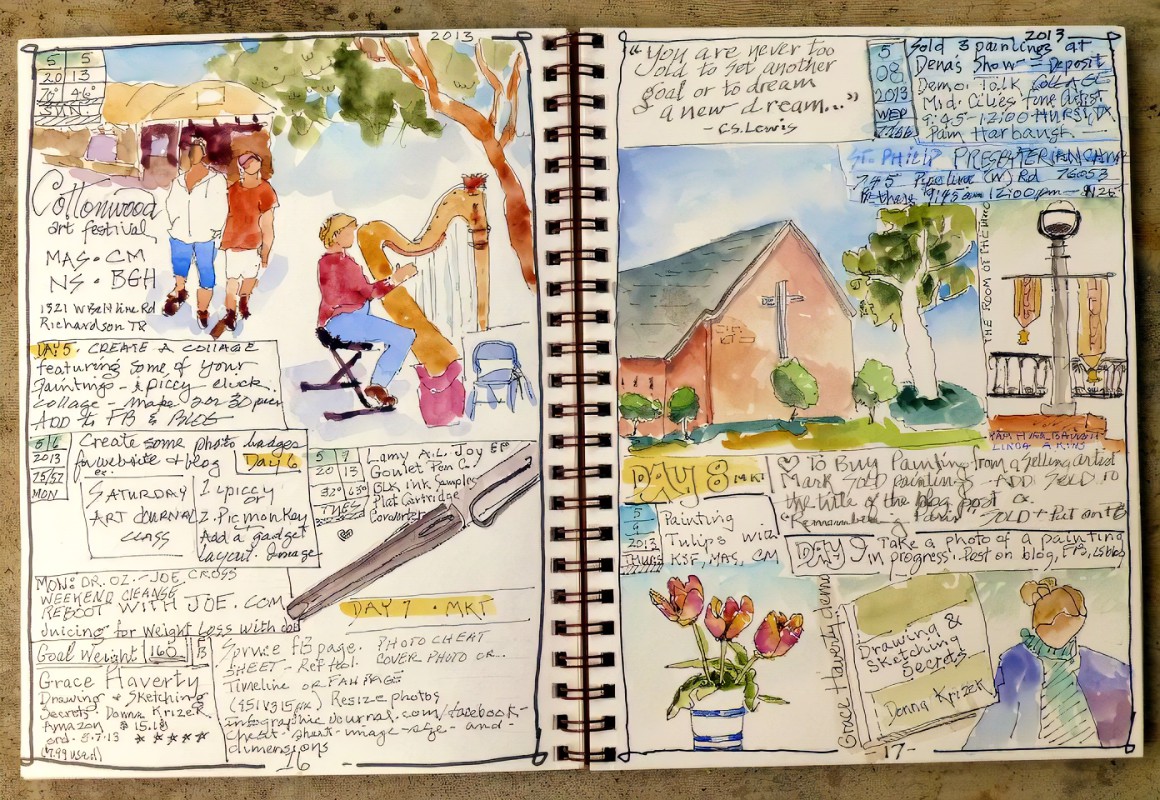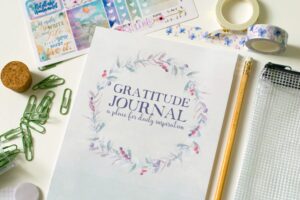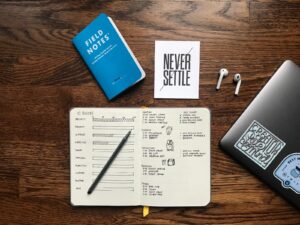As a creative person, I’ve found that sketchbook journaling is one of the most rewarding and fulfilling activities I can do. It allows me to express myself visually and emotionally while also keeping my skills sharp and my ideas fresh.
In this ultimate guide to sketchbook journaling, I’ll share everything I’ve learned about this wonderful practice, from the benefits to the techniques, from the prompts to the inspiration, and much more.
Introduction to Sketchbook Journaling
Sketchbook journaling is a form of art therapy that combines drawing, painting, writing, and collage in a personal, introspective, and experimental way. It’s not about creating masterpieces or impressing others, but about exploring your own thoughts, feelings, and experiences through the medium of a sketchbook. Sketchbook journaling can help you:
- Process emotions: By visualizing and analyzing your emotions, you can better understand and cope with them.
- Boost creativity: You can experiment with different techniques and materials and expand your artistic skills and imagination.
- Record memories: Documenting your life events and observations helps you create a tangible record of your personal history.
- Relieve stress: By focusing on the present moment and letting go of perfectionism, you can reduce anxiety and tension.
Benefits of Sketchbook Journaling
Sketchbook journaling has numerous benefits for both mental and physical health. Here are some of the most significant ones:
- Reducing stress: According to research, art therapy can lower cortisol levels, which is the hormone associated with stress.
- Improving mood: Art therapy can increase dopamine and serotonin levels, which are the neurotransmitters associated with pleasure and happiness.
- Enhancing self-esteem: This type of journaling can boost confidence and self-worth by providing a sense of accomplishment and self-expression.
- Strengthening cognition: It can improve cognitive functions such as memory, attention, and problem-solving by stimulating the brain.
- Alleviating pain: Sketchbook journaling can reduce physical pain and discomfort by distracting the mind and promoting relaxation.
Getting Started with Sketchbook Journaling
If you’re new to sketchbook journaling, here are some tips to help you get started:
- Set aside a regular time and place for sketchbook journaling. This will help you establish a routine and create a conducive environment for creativity.
- Gather your supplies. You don’t need expensive or fancy materials to start sketchbook journaling. Just get a sketchbook, a pen, and some colored pencils or watercolors, and you’re good to go.
- Choose a theme or a focus for your sketchbook journal. This will give you a direction and a purpose for your art and help you avoid feeling overwhelmed or lost.
- Experiment with different techniques and styles. Don’t be afraid to try new things, even if you’re not sure if they will work or not. Sketchbook journaling is all about exploration and discovery.
- Don’t judge or criticize your art. Remember that your sketchbook journal is a personal and private space and that you’re not creating art for others to judge or evaluate. Focus on the process, not the product.
Choosing the Right Sketchbook and Supplies
The choice of sketchbook and supplies can greatly affect your sketchbook journaling experience. Here are some factors to consider when selecting them:
- Size: The size of your sketchbook should be comfortable and convenient for you to carry and use. A common size is 8.5 x 11 inches, but you can also choose smaller or larger ones.
- Paper quality: The quality of your sketchbook paper should match your preferred medium and style. If you like to use watercolors or markers, choose a sketchbook with thick and smooth paper that doesn’t bleed or warp.
- Binding: The binding of your sketchbook should be durable and flexible. A spiral or ring binding allows you to lay your sketchbook flat and turn pages easily, while a perfect binding gives your sketchbook a more professional look.
- Cover: The cover of your sketchbook should reflect your personality and taste. You can choose a plain or patterned cover, a soft or hard cover, or a customizable cover that you can design yourself.
- Supplies: The supplies you choose should suit your budget and preferences. Some basic supplies include pens, pencils, erasers, rulers, and sharpeners. For color, you can use colored pencils, markers, watercolors, or pastels.
Sketchbook Journaling Techniques
There are countless techniques and styles you can use in sketchbook journaling, depending on your mood, subject, and medium. Here are some of the most popular ones:
- Doodling: Doodling is a spontaneous and playful way to fill your sketchbook pages with patterns, shapes, and lines. It can help you relax and focus your mind.
- Collage: Collage is a creative and versatile way to combine images, textures, and colors in your sketchbook. You can use magazine cutouts, photos, stickers, or your own drawings.
- Observational drawing: Observational drawing is a realistic and detailed way to capture the world around you in your sketchbook. You can draw objects, people, landscapes, or animals.
- Abstract drawing: Abstract drawing is a free and expressive way to explore your emotions and ideas in your sketchbook. You can use colors, shapes, and lines to create a mood or a theme.
- Mixed media: Mixed media is a bold and experimental way to combine different materials and techniques in your sketchbook. You can use paint, ink, markers, paper, fabric, or anything else you can think of.
Sketchbook Journaling Prompts and Ideas
Sometimes, you may feel stuck or uninspired in your sketchbook journaling. That’s when prompts and ideas can come in handy. Here are some prompts and ideas to spark your creativity:
- Draw your favorite childhood memory.
- Illustrate a dream or a fantasy.
- Create a visual representation of your current mood.
- Draw a portrait of someone you admire.
- Make a map of your hometown or your favorite place.
- Use a song lyric or a poem as inspiration for your sketch.
- Draw a series of faces expressing different emotions.
- Create a pattern or a design based on a natural element.
- Draw your ideal day or your worst nightmare.
- Make a collection of objects that have special meaning to you.
Sketchbook Journaling Inspiration
Inspiration can come from many sources, both internal and external. Here are some ways to find inspiration for your sketchbook journaling:
- Nature: Take a walk in the park, the beach, or the forest and observe the colors, shapes, and textures around you. You can also collect leaves, flowers, or stones and use them as references or materials in your sketchbook.
- Art: Visit a museum, a gallery, or an art fair and discover new artists, styles, and techniques. You can also browse art books or websites and learn from the masters or their contemporaries.
- Media: Watch a movie, a TV show, or a documentary and immerse yourself in different stories, cultures, and perspectives. You can also read a book, a magazine, or a blog and get inspired by different genres, topics, and voices.
- People: Talk to your friends, your family, or strangers, and listen to their stories, opinions, and experiences. You can also observe their gestures, expressions, and postures and sketch them in your sketchbook.
- Yourself: Reflect on your own thoughts, feelings, and experiences and express them in your sketchbook. You can also experiment with different techniques and materials and challenge yourself to try new things.
Advanced Sketchbook Journaling Techniques
Once you’ve mastered the basics of sketchbook journaling, you may want to explore more advanced techniques and styles. Here are some examples:
- Blind contour drawing: Blind contour drawing is a fun and challenging way to improve your observational skills and your hand-eye coordination. You draw a subject without looking at the paper and create a continuous line that captures the contours and details of the subject.
- Negative space drawing: Negative space drawing is a creative and abstract way to see and draw shapes and forms in a different way. You focus on the space around and between the objects, rather than the objects themselves, and create a composition that is both graphic and poetic.
- Ink wash drawing: Ink wash drawing is a versatile and expressive way to create tonal values and textures in your sketchbook. You use a brush or a pen to apply ink to the paper, and then you add water to create different shades and effects. You can use ink wash for portraits, landscapes, or abstract art.
- Travel sketching: Travel sketching is a dynamic and immersive way to capture the essence and beauty of a place in your sketchbook. You can use a small and portable sketchbook and draw on location, whether you’re in a café, a park, or a museum. You can also use different techniques and materials, such as watercolors, markers, or pencils.
- Digital sketching: Digital sketching is a convenient and versatile way to create and edit your sketches using a tablet or a computer. You can use a stylus or a mouse to draw and paint, and you can save and share your work in different formats and on different platforms. You can also use different software and apps, such as Procreate, Adobe Illustrator, or Sketchbook Pro.
Sharing Your Sketchbook Journal
Sharing your sketchbook journal can be a rewarding and inspiring experience, as it allows you to connect with others, get feedback, and learn from their perspectives. Here are some ways to share your sketchbook journal:
- Social media: You can share your sketches on social media platforms such as Instagram, Facebook, or Twitter and use hashtags to reach a wider audience. You can also follow other sketchbook journalers and get inspired by their work.
- Blogging: You can create a blog or a website dedicated to your sketchbook journaling and share your sketches, your techniques, your prompts, and your ideas with others. You can also collaborate with other bloggers or artists to create a community of sketchbook journalers.
- Exhibiting: You can participate in art exhibitions or fairs and showcase your sketches in a public setting. You can also sell your sketches or donate them to charity or art organizations.
- Workshops: You can teach workshops or classes on sketchbook journaling and share your knowledge and skills with others. You can also attend workshops or classes and learn from other sketchbook journalers.
Sketchbook Journaling Tips and Tricks
Here are some additional tips and tricks to enhance your sketchbook journaling experience:
- Use a pencil or a light-colored pen to sketch your ideas before committing to a final drawing.
- Experiment with different textures and surfaces, such as sandpaper, fabric, or cardboard.
- Create a color palette or a theme for each page or spread.
- Use your non-dominant hand to draw and see what happens.
- Incorporate quotes, lyrics, or poems into your sketches.
- Draw with your eyes closed or while listening to music, and let your intuition guide you.
- Use negative feedback or criticism as an opportunity to learn and grow, rather than as discouragement or rejection.
- Take breaks and step back from your sketchbook when you feel stuck or frustrated.
- Practice regularly and persistently, and don’t be afraid to make mistakes or fail.
- Have fun and enjoy the process!
Sketchbook Journaling Resources and Communities
Here are some resources and communities for sketchbook journaling:
- Sketchbook Skool: online classes and workshops on sketchbook journaling and other art topics
- The Sketchbook Project is a collaborative art project and a library of sketchbooks from around the world.
- Urban Sketchers is a global community of sketchers who document the world one sketch at a time.
- The Art of Journaling is a blog and podcast on different forms of journaling, including sketchbook journaling.
- The Creative Life Podcast is a podcast on creativity, art, and inspiration, with interviews and insights from artists and creators.
Conclusion
Sketchbook journaling is a wonderful and enriching practice that can benefit your mental and physical health, as well as your creativity and self-expression. By following the tips, techniques, and inspiration in this ultimate guide, you can start or improve your sketchbook journaling journey and discover new aspects of yourself and the world around you. Remember, your sketchbook journal is your personal and private space where you can experiment, explore, and express yourself freely and authentically. Happy sketching!




No comments! Be the first commenter?